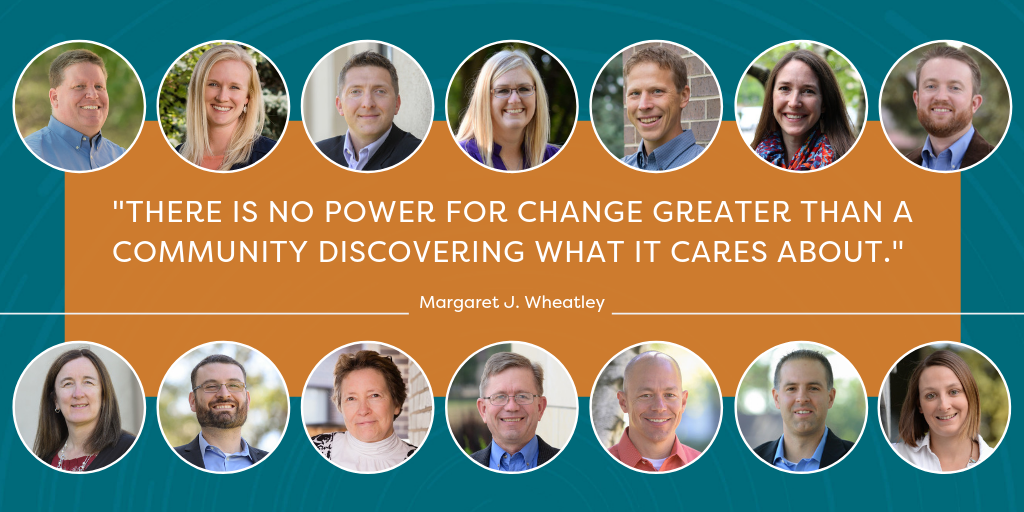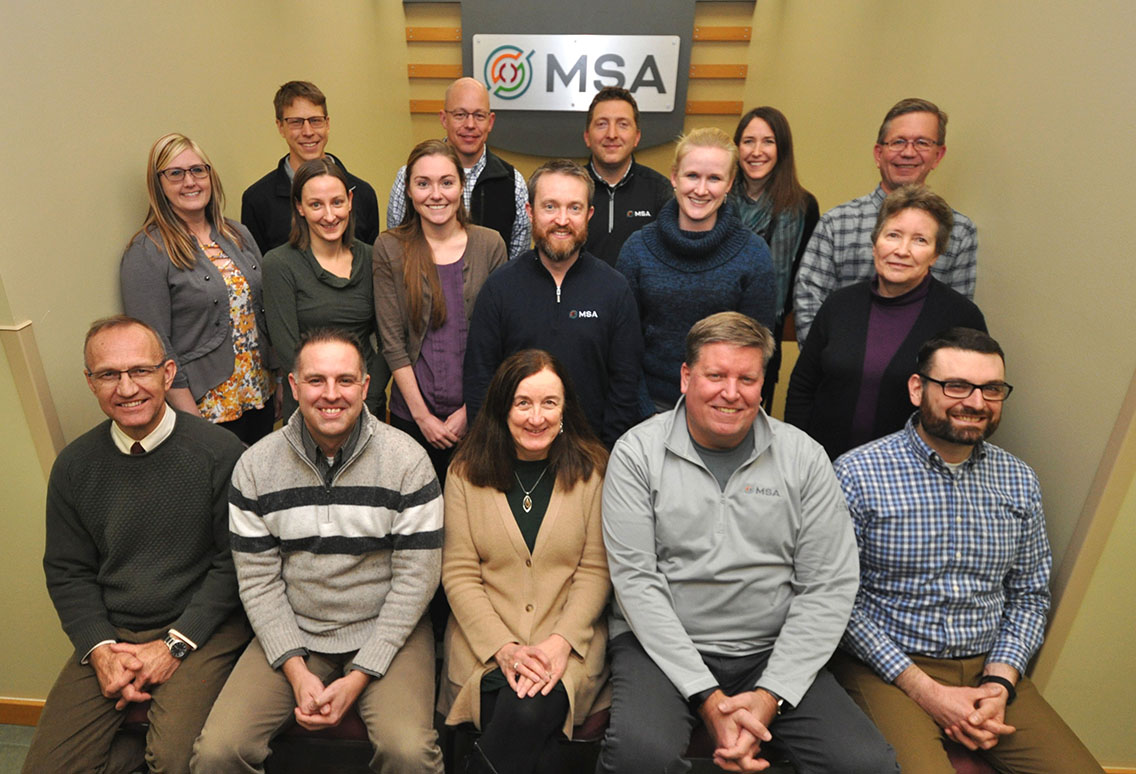Communities of Practice (CoPs) are bodies of individuals who actively share in—and commit to advancing—a common interest or professional practice.
They are fellowships, built on trust and accountability. As such, they commit to learning together and applying their shared set of knowledge and competence toward the improvement of the public good.
At MSA, CoPs were introduced as key initiative after a strategic planning session in 2013. We had grown from a small, Wisconsin-founded surveying partnership into a diverse, multi-disciplinary firm with 16 office locations across six different states. In order to continue to evolve and equally strengthen those service lines, we launched the creation of Communities of Practice. Individually, these CoPs meet and communicate on a regular basis to deepen their own expertise and generate new ideas. As a whole, they offer something even greater to our clients and community partners: an elevated level of proficiency, adaptability and community-based solutions.

What do you think is the largest benefit of the CoP model at MSA?
Eric P.: I think the largest benefit is the exchange of information that occurs in an environment dedicated to collaboration and learning. This space provides a time to reflect and grow within the constraints of a particular project or discipline.
Jayne: We have members in different offices, on different teams, in different programs – so the CoP model helps us to bring people together who are working in the same service area. It helps each of us develop new approaches, get to know each other better and develop standardized practices across the company.
Mary: The CoP provides a centralized way to disseminate and exchange information, field questions or problem-solve issues.
Amber: I think the greatest benefit is in identifying the experts and generating novel solutions using the team’s collective skillsets. CoPs also allow for the sharing of knowledge and cross-selling of services between each of the groups.
John: CoPs provide a space for knowledge sharing, collaboration, and critical mass to further develop our service lines and better serve our clients.
Current industry trends. What is most exciting to your group?
Brad: There are always new challenges when it comes to water quality and treatment. Awareness of what’s in drinking water seems to grow each year, which is a good thing. We look forward to seeing how BIM and 3D design can affect planning for potable water projects and how the integration of GIS and water system knowledge (e.g. asset management) will elicit better decision making by individuals and municipalities.
Jaime: BIM, 3D, drones, automation…lots of exciting things happening.
Andrew: Urbanization 2.0. Increasingly, suburban and smaller communities are embracing core planning principals. They are looking to implement projects that make their community more walk and bike friendly, incorporate cohesive and decorative streetscaping and wayfinding, embrace the development of mixed-use and a mixed-workforce housing units, make improvements to parks and outdoor art or gathering places as a means to improve the community and attract new residents and businesses.
Steve: 3D modeling as it relates to the field of surveying.
Eric P.: Sustainable design practices are a necessity of our industry moving forward. Buildings represent a huge portion of greenhouse gases released into our environment. Material and technology advances give us ways to address these type of issues. It will be exciting to see how this becomes a reality moving forward.
Amber: So many things! Integration of BIM and GIS, expanded mobile device capabilities, Machine Learning applications (e.g. Esri helping to track things like Zika virus outbreaks), automation of mundane tasks, local vehicle LiDAR, Smart Cities – using data to drive planning efforts on a systemic level.
Kevin: Autonomous vehicle testing is both exciting and challenging. The evolving connectedness between people, devices, technology and infrastructure is fun to watch, as is the growth in multi-modal capabilities.
Eric T.: 2D modeling, natural system restoration, advanced research on stormwater (quality) management BMPs.
Greg: Water reclamation and resource recovery. It is not “waste” water, but rather a vital resource than can be recovered and repurposed. We talk a lot about various treatment technologies and nutrient removal toward this end.
What industry hurdles is your CoP discussing or most interested in helping to overcome?
Mary: Funding depends on both state and federal budgets every year. It can also be quite politically driven, so legislative changes may either help or hurt funding for projects and communities. Keeping an eye on the consistency and longevity of programs keeps us on the edge of our seat.
Raine: Lack of funding, and how to collect better data on park and rec users to help adapt the industry to meet the users’ needs. We’re also talking more about resiliency and sustainable design. As the climate continues to change, we need to address how our designs need to change as a result.
Jill: We’re always looking for means to improve our technology and skills and are committed to staying current with the latest trends and efficiencies in order to support our internal users and the deliverables they create for our clients.
Andrew: How to always increase the level of public engagement in the planning process, particularly using new technology to provide methods of community engagement.
Brad: There are a lot of topics we discuss, and many of concern with regards to safe, clean drinking water. Changes in regulation, an increase of lead and PFAS found in drinking water, filling the service gap in water facility operations. There are also emerging contaminants of concern, and we need to help provide the solutions.
Eric T.: Right now, regulations are outpacing research and technology, which forces the design of Best Management Practices that are based on dogma and often do not function as intended. We need to resolve that.
Steve: We discuss how to better process point cloud data as generated by scanning, to stay on top of the trends.
John: The current—and trending—lack of funding for municipal infrastructure projects is a problem. We also are focused on learning how to more effectively harness technological advances in order to better serve our clients.

CoP Leaders gather for their annual flocking!
Each CoP is encouraged to hold a “flocking” event each year. It has been said that birds that flock tend to learn faster. How does your flocking foster learning and evolution as a group?
Jill: Our flockings help build relationships and teamwork, supporting our fellow employee-owners at MSA, and by extension – supporting all of our clients and community partners as well.
Eric P.: The flockings really provide an opportunity to develop personal relationships within the group. Once that relationship is established, the ability to communicate on a regular basis with our technological capabilities becomes much more effective.
Jayne: The flocking event is very important as it is frequently the only time that we get to see some of the other people in our service area face to face. It increases our comfort level in working together on marketing and project development.
Greg: Flocking is a great way to advance our technical expertise and create methods of standardization within our practice. In the process, we’re building relationships, and it seems people are more likely to share knowledge and work with people they know. Plus, it helps with the development and professional growth of our younger staff.
Raine: We really enjoy doing team-building events that incorporate park and rec design and planning efforts. As a group, we obviously all like to partake in recreation as well, so some favorite group activities have been curling and skiing together.
Brad: At our last flocking event, I really grew in my appreciation of the talent and skills of my fellow CoP members!
What are your CoP’s goals and how do they improve the MSA client experience?
Jaime: The Design Technology CoP truly crosses every aspect of what we do at MSA and it impacts everyone. We want to improve our community and how we get our work done to produce the best deliverables possible.
Kevin: We’re looking forward to implementing more design technology—3D plans and such—to help the client better visualize projects and to help engineering refine them. We also hope to bring greater attention to multimodal opportunities within communities, helping clients plan as trends shift toward more bicycle, pedestrian, battery or electric-assist mobility devices.
Mary: Our goal is to make sure each MSA team member who has contact with clients understands the appropriate funding options so that each client gets the best deal possible for their work needed.
Amber: Providing better internal awareness of what is possible with GIS [is a priority for us]. We can continue to improve our project deliverables and provide better service to our clients by leveraging the power of GIS. We can also better use analysis capabilities to build resilience into our civil infrastructure. Find the weak links first and develop a solution to solve problems before they arise rather than reacting to problems after the fact.
John: Simply put, we are better together. That continues to drive us forward.
Raine: We are excited to continue to work on custom and unique designs and regionally collaborative projects. We will continue to push for more engagement with the public to develop a better understanding of the community and the people within them.
Eric T.: The Stormwater CoP builds a community by sharing knowledge developed principally by the Water Resources team with other stormwater practitioners across the company. This mechanism provides better services to our clients (internal and external), allows MSA to provide superior service and bolsters confidence and morale.
Brad: We simply strive to make an impact for the good. As Benjamin Franklin said, “When the well is dry, we’ll know the worth of water.”
Andrew: The goal is to live our purpose in all projects: enabling people to positively impact the lives of others.